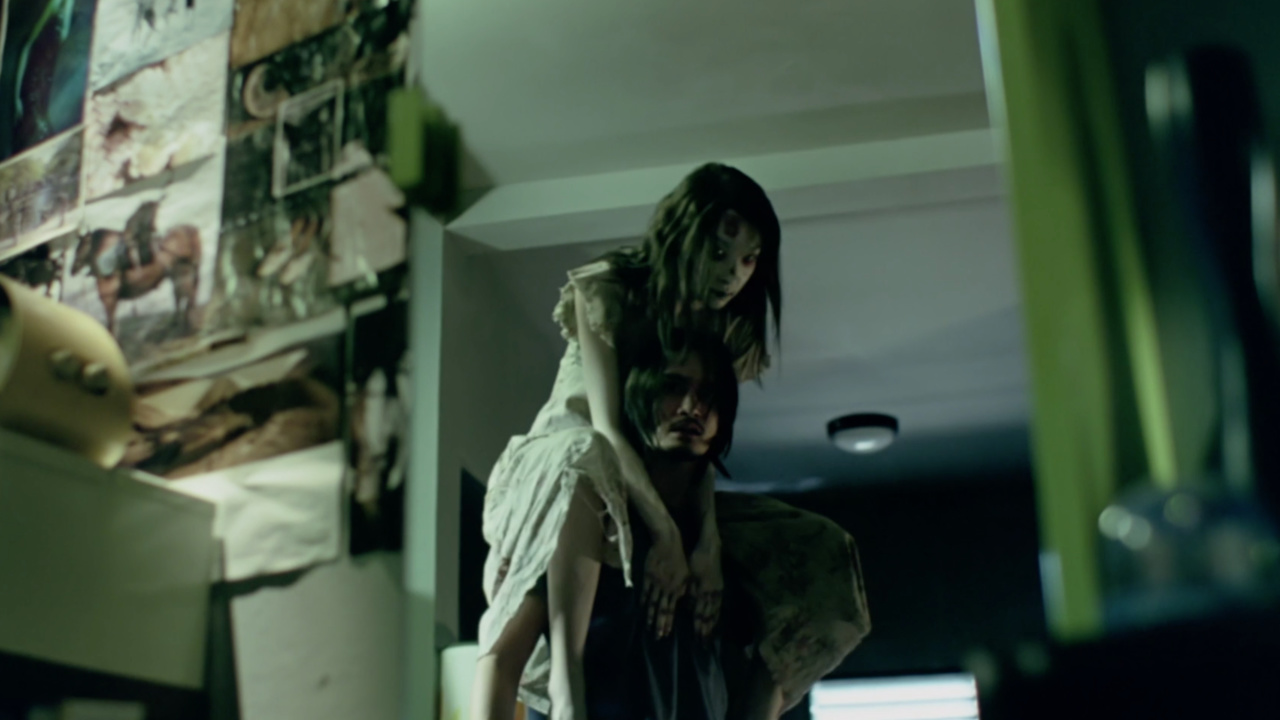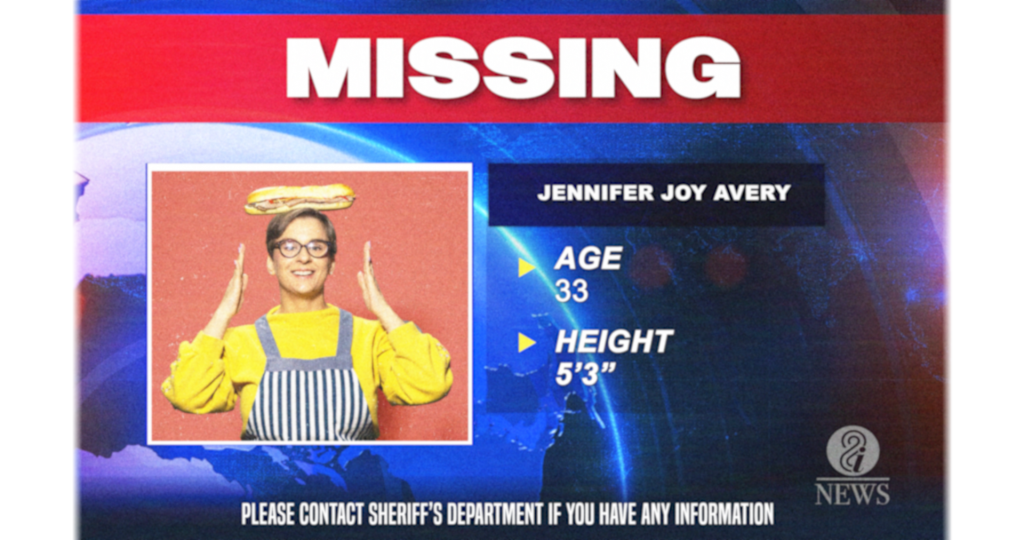Reviews
[REVIEW] BHFF 2024: ‘Who’s Watching’ (I’m Watching! And I Will Watch Again!)
Who’s Watching follows Caleb (Zachary Ray Sherman), a weird, creepy, and downright off-putting, self-obsessed loner. Caleb finds himself creating a “documentary” at his uncle’s business. The “documentary” quickly reveals itself to be centered around his coworker Krista (Gracie Gillam), turning from oddly quirky to insidiously dangerous. The narration around Caleb’s film gets murky when one of his band’s friends, Tawnia (Olivia Luccardi), enters the picture. Who is filming who? And who, exactly, is watching?

It’s officially time to apologize for something heinous I said years ago. I’ve grown and learned from my mistakes. Out of all the film genres, horror has been known to fall into phases. Post 9/11, the horror genre saw an influx of angry slasher films, like The Hills Have Eyes, the Friday the 13th remake, and a rise in zombie films. The xenophobic fear felt by countries all around the world propelled these types of films into horror’s zeitgeist. Around the mid-aughts, the genre would make a hard transition into an overabundance of low-budget found footage films.
While there may or may not have been political or social reasons behind this shift, I thought it would just be a phase. It’s not. Many times, I’ve gone on record, saying found footage will hit a plateau and the subgenre will die out. But with films like The Outwaters, Malibu Horror Story, Horror in the High Desert, Strange Harvest: Occult Murder in the Inland Empire, The Ceremony is About To Begin, Frogman, and Hell House LLC Origins: The Charmichael Manor, it’s clear I was wrong. So what was it that finally flipped the switch in my head? What was the film that made me realize I couldn’t have been more wrong?
What was the film that made me realize I’m living in the midst of found footage’s second (or third) wave? Who’s Watching.
Who’s Watching follows Caleb (Zachary Ray Sherman), a weird, creepy, and downright off-putting, self-obsessed loner. Caleb finds himself creating a “documentary” at his uncle’s business. The “documentary” quickly reveals itself to be centered around his coworker Krista (Gracie Gillam), turning from oddly quirky to insidiously dangerous. The narration around Caleb’s film gets murky when one of his band’s friends, Tawnia (Olivia Luccardi), enters the picture. Who is filming who? And who, exactly, is watching?
Writer/director Tim Kasher is one hell of a filmmaker. I had no clue he was the composer of the brilliant film My Suicide (aka Archie’s Final Project) which stars Zachary Ray Sherman. When the film was introduced, I found out just how much people love Kasher. His band Cursive was mentioned, and the house went wild. Kasher is an astounding composer, musician, and filmmaker—a real triple threat. Who’s Watching is Kasher’s sophomore feature, and it’s a gorgeous blend of found footage and traditional filmmaking. It’s one of the few times a found footage film answers the question of how the film we’re watching was edited (with music, titles, etc.).
When it comes to found footage/POV filmmaking, the lead characters, or at least those with most of the screen time, must succeed for the film to work. The most frustrating FF/POV films are those with constantly peaked audio and actors who think loud and annoying is an acting choice. Luckily for Kasher, he struck gold with his three leads.

Zachary Ray Sherman excels as a red-pilled 4Chan incel. Even though Sherman is handsome in the real world, his behind-the-dollar-store haircut and general unpleasantness craft the character of Caleb into a truly terrifying antagonist. What’s most disheartening about his performance is its raw authenticity. Even when his character acts in a way that seems over the top, it’s unfortunately not too far off from something you’d see in a YouTube true crime breakdown video. The character of Caleb was etched into my brain long after the credits rolled. It left me looking over my shoulder while waiting for the L train to arrive.
Gracie Gillam is just a pure joy to watch. From her start in 2011’s Fright Night, to a stint on Vampire Diaries, all the way through the highly underappreciated Z Nation, Gillam has made quite a name for herself in the horror scene. Who’s Watching is another stellar mark in her glowing oeuvre. She plays the damsel in distress incredibly well and absolutely makes the finale her bitch.
Olivia Luccardi is the epitome of the “good for her” trope. Like Gillam, Luccardi is no stranger to horror as she played Yara in It Follows (you know, the person with the clamshell eReader!). There’s a real slow burn for Tawnia, she’s naturally unassuming until you realize what’s actually going on. Let’s just say, there’s a twist in the film that had nearly the entire theater gasping.
It’s clear that Kasher had a distinct vision with Who’s Watching, and that vision is horrific. During the Q&A after the film, Luccardi revealed that while they were told what to film, they were allowed to make the shooting scenes their own. And, to me, that’s what makes Who’s Watching such an impressive feature. Allowing your actors to exist within their characters and let them film what they think needs to be filmed, or what they think they would notice if they were in this predicament, which adds another level of credence to this film.
Found footage and POV films rarely have deep characters and character development. Who’s Watching is a film that knows what it is, what it needs to be, and what story is necessary to tell at certain points. From the deep character developments to the astounding visual choices, this film is one that you will not forget for a long time. I have no clue if Tim Kasher and Joel Potrykus know each other, but their styles are strikingly similar while still existing within their own unique and artistic worlds. If the two of them got together and made an anthology film, I think the world would implode.
You’ve never seen a found footage film like Who’s Watching. The only question you have to ask yourself as you leave the theater is, “How’d you like that fucking movie?”
Reviews
‘Shutter’ (2004) Review: Is Aughts-ful

The aughts were the wild wild west when it came to remakes and reboots. One subgenre that excelled in striking fear into the hearts of North Americans was unquestionably J-horror. It was a craze that gave a 10-ish-year-old me nightmares for too much of my childhood. Out of all of the J-horror remakes that frightened me, the one I never got around to checking out was Shutter. Which is what I was initially going to open this review with. That was until I realized that Shutter wasn’t a J-horror remake! Talk about egg on my face!
A Haunting Tale in Japan
Shutter follows Ben Shaw (Joshua Jackson), a seasoned photographer who moves to Japan with his new wife Jane (Rachael Taylor). Their first night in Japan gets off to an awful start when Jane runs over a mysterious woman at night. Jane starts seeing this mysterious woman throughout her daily life, and Ben’s photos become unusable when a spirit takes them over one by one. Is this spirit coming after Ben and Jane for the accident? Or, is this spirit haunting them for a more sinister reason?
This hastily assembled remake is directed by Masayuki Ochiai and written by Luke Dawson. After Shutter, Dawson’s only other notable script would be the 2015 flop The Lazarus Effect. Which is what I was initially going to write until I learned that The Lazarus Effect brought in nearly $40 million at the box office. It’s difficult to say what the worst part of Shutter is, but the script is definitely at the top of that list. Not only is the script boring and bereft of any real terror, but the characters are beyond flat. Even without having seen Shutter (2004), it was clear what direction this film was taking, and any suspense that could have existed flew right out the window.
Failed Cultural Commentary
Dawson’s script attempts to take a look at white people forcibly inserting themselves into a culture and making it all about themselves. But it’s such a surface-level observation and handled with the care of a five-year-old’s crayon drawing that it’s nearly laughable. At the very least, Shutter does succeed at being a good-for-her film. And for that, I can tip my hat.
Director Masayuki Ochiai and cinematographer Katsumi Yanagijima fail to explore any space in any meaningful way. Japan is a beautiful location, and it’s completely wasted throughout this film. The only really visually interesting moment is the well-choreographed car crash. From there, things quickly go downhill. I’m sure there’s a way to make a film about spirit photography feel interesting and scary, but this is definitely not the right approach.
Shutter is a Forgettable Horror Flop
I’ve covered a lot of films during my tenure at Horror Press that I’ve never seen before. It’s a gamble I’m happy to risk. Whether they hit or miss doesn’t usually matter to me. For some reason, I held Shutter in high regard. I thought people were over the moon for this film. I suppose I can add this to my list of films, such as The Barrens and Warm Bodies, as ones I could easily consider a complete waste of time.
Reviews
Brooklyn Horror Film Festival 2025: ‘Buffet Infinity’ Review

Within the found footage subgenre exists an even more niche and untapped market. Screen life has slowly overtaken found footage; hardcore fans, like myself, ache for something different. One of the more interesting sub-subgenres of found footage is something that I don’t think has a name yet, so let’s name it here and now. How about…TV-gone-rogue! The TV-gone-rogue subgenre is small. Ghostwatch got the ball rolling for these gone rogue-like films, but there was radio silence for quite some time. It would be Chris LaMartina’s WNUF Halloween Special that really brought this idea back into the limelight. Many filmmakers have tried to make TV-gone-rogue interesting, and many have failed. That is until Simon Glassman stepped onto the scene with Buffet Infinity.
Buffet Infinity: A Chaotic Tale of Westridge
The town (city?) of Westridge is whisked into chaos when the new Buffet Infinity restaurant rolls into town. Local sandwich shop owner Jennifer Avery (Allison Bench) is the first to take the soon-to-be conglomerate to task with increasingly pointed advertisements. Suddenly, local restaurant owners/workers go missing in droves as Buffet Infinity expands into neighboring businesses. Sinkholes, missing cityfolk, quarantines, and mysterious sounds abound, leaving residents to ask one question…who really has the sauce?
On the Brooklyn Horror Film Festival schedule, the header image for Buffet Infinity shows multiple people T-posing and floating in the sky. I was immediately sold. I had no clue what I was getting into, and I didn’t want to know. The film was introduced as “one of the craziest we have this year.” (Slightly paraphrasing.) What was I about to watch? Little did I know, it was about to be an hour and forty minutes of small-town madness.
Writers Allison Bench and Elisia Snyder, and writer-director Simon Glassman, transport viewers into an upside down world of weaponized local ads; a thriving town invaded by the deep pockets of monopolized capitalism. As someone who grew up in a decently sized town, though probably not large enough to be considered a city, there was a tinge of nostalgia that accompanied Buffet Infinity. Westridge feels cozy and intimate, a town where everyone knows your name. It’s a “baked in a buttery flaky crust” town. Sure, they have their McDonald’s and Burger Kings, but the real townsfolk eat at Jennifer’s sandwich shop–local knitting circles murmur about what they think is in Jennifer’s secret sauce. Simply put, Westridge feels like a home that many people like myself grew up in. And it reminds us of a simpler time that’s long gone.

A Unique Blend of Humor and Eldritch Terror
Buffet Infinity hides its horror well. It slowly guides the viewer into a sense of unease. As easily as the creators have you laughing, they have you squirming. The absurdist joy quickly transforms into Eldritch terrors from beyond. Many filmmakers say they’re inspired by the idea of it’s-not-what-you-see that’s scary, but many times it feels performative. Bench, Glassman, and Snyder have crafted a truly special script that edges you with terror and excitement. They constantly push you to the edge of release, and then back away. It’s the Japanese water torture of exposition. And, for me, it works incredibly well.
One of the most important aspects of Buffet Infinity is the over-capitalization of our lives. While the creators tackle this idea in a tongue-in-cheek manner, their message is highly effective. For the most part. This constant tete-a-tete between Buffet Infinity and the locals is highly amusing, but brings a larger conversation to the forefront. The town I grew up in is a shadow of what it once was. And I know many feel the same about the towns they grew up in. I can already hear the moans of people who dislike this film: “Brandon, it’s not that deep.” And I would highly disagree. Buffet Infinity feels like a reflective protest film–a loud and proud middle finger at what we should have said when the Super Walmart put mom and pops out of business.
Sorry, this review has gone off the rails. Let’s reel it back in a bit.
Why Buffet Infinity Redefines Found Footage
Buffet Infinity is a riotous romp, a hilarious horror that goes from zero to 100 pretty damn fast. Each commercial slowly builds on its last and uniquely tells its story. This film sets a new precedent for the TV-gone-rogue subgenre. Not to directly compare, but a film like WNUF Halloween Special (a film I love) uses its commercials as a coda; it’s a separation of what you saw/heard and prepares you for the next movement. Buffet Infinity uses its commercial to create the story. Instead of watching news pieces, then irrelevant commercials, then back to news pieces, Buffet Infinity breaks the mold. Hell, it creates the mold.
As someone who has been dying to see a Welcome to Nightvale film, Buffet Infinity is the closest thing I could ask for. It is full of killer performances (looking at you, Ahmed Ahmed), is well-crafted, and sets a new precedent on an underutilized side of found footage. Buffet Infinity is a full-course meal. I highly suspect that Buffet Infinity will gather the unwavering support that Hundreds of Beavers gathered and will go on to be considered an instant classic of the 2020s.























